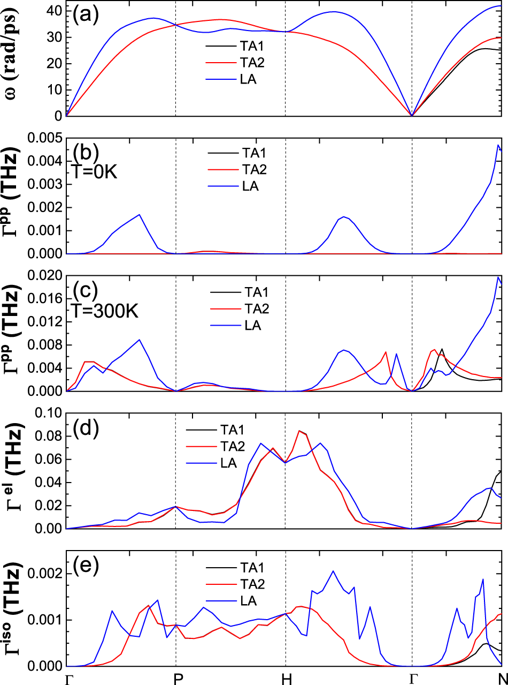npj Computational Materials ( IF 9.7 ) Pub Date : 2019-10-08 , DOI: 10.1038/s41524-019-0235-7 Yani Chen , Jinlong Ma , Shihao Wen , Wu Li

|
It was recently found that the anharmonic phonon–phonon scattering in tungsten is extremely weak at high frequencies, leading to a predominance of electron–phonon scattering and consequently anomalous phonon transport behaviors. In this work, we calculate the phonon linewidths of W along high-symmetry directions from first principles. We find that the weak phonon–phonon scattering can be traced back to two factors. The first is the triple degeneracy of the phonon branches at the P and H points, a universal property of elemental body-centered-cubic (bcc) structures. The second is a relatively isotropic character of the phonon dispersions. When both are met, phonon–phonon scattering rates must vanish at the P and H points. The weak phonon–phonon scattering feature is also applicable to Mo and Cr. However, in other elemental bcc substances like Na, the isotropy condition is violated due to the unusually soft character of the lower transverse acoustic phonon branch along the Γ-N direction, opening emission channels and leading to much stronger phonon–phonon scattering. We also look into the distributions of electron mean-free paths (MFPs) at room temperature in tungsten, which can help engineer the resistivity of nanostructured W for applications such as interconnects.
中文翻译:

钨的体心立方结构和弱非谐声子散射
最近发现,钨中的非谐声子-声子散射在高频下非常弱,导致电子-声子散射占主导地位,从而导致异常的声子传输行为。在这项工作中,我们计算W的声子线宽遵循第一原则的高对称性方向。我们发现弱的声子-声子散射可以追溯到两个因素。首先是声子在P和H点处的三重简并性,这是元素体心立方(bcc)结构的普遍性质。第二个是声子分散体的相对各向同性的特征。当两者都满足时,声子-声子的散射速率必须在P和H点消失。声子-声子的弱散射特性也适用于Mo和Cr。但是,在诸如Na的其他元素bcc物质中,由于下部横向声子声子沿Γ-N方向的异常柔软特性,开放的发射通道并导致更强的声子-声子散射,因此违反了各向同性条件。W用于互连之类的应用程序。


























 京公网安备 11010802027423号
京公网安备 11010802027423号